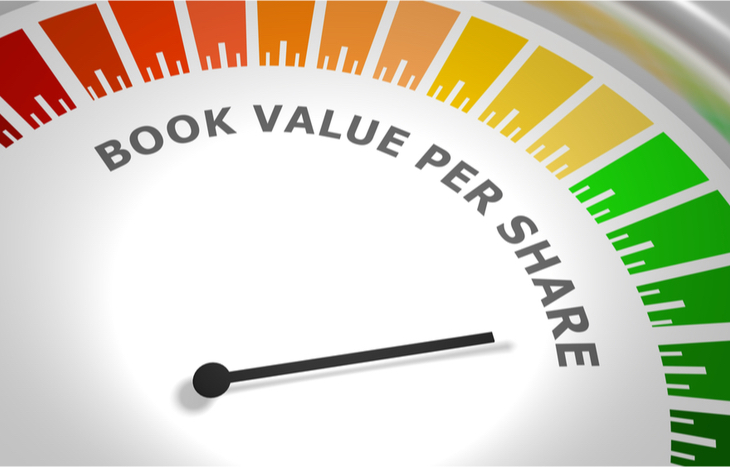What is Book Value Per Share (BVPS)?
When you buy stock in a company, you’re buying an equity stake. The value of that equity stake will change over time: growing and shrinking in tandem with company performance. Much of this is dependent upon market sentiment: what someone else is willing to pay for that stake if you choose to sell. Investors who want a clear, unbiased valuation of their equity stake use metrics like book value per share (BVPS) to fundamentally understand what it’s worth.
Book value per share represents the intrinsic value of one share of a company. If that business closed up shop and liquidated tomorrow, the BVPS is what each shareholder would receive as a payout for their equity stake. It’s an important figure to know because, used as a benchmark, it can show how under- or overvalued the current stock is by the market.
Here’s a deeper dive into book value per share, how to calculate it, what it means and how to use it as an evaluative metric when understanding stock prices.

How to Calculate Book Value Per Share
To understand book value per share, investors need to look at the company’s balance sheet. Specifically, the shareholder equity represented (total equity minus preferred equity). Divide this equity by the total number of outstanding shares to get the BVPS price:
BVPS = Total Shareholder Equity / Total Outstanding Shares
For example, if ABC Company has $750 million in shareholder equity on its balance sheet and total outstanding shares of 50 million, its BVPS is $15. This is how much every shareholder would receive after the company liquidates and pays its debts. Note that preferred shareholder equity isn’t included in this calculation because these shareholders receive priority claim in the event of liquidation.
At a Glance: High vs. Low Book Value Per Share
Investors using book value as an evaluative metric are looking at how far above or below the current market value per share it is. BVPS is a useful benchmark for determining whether a stock is undervalued or overvalued by the market, and by how much. This is usually accomplished through comparative metrics like book-to-market ratio.
- If the book value is lower than the market value, it’s an overvalued signal
- If the book value is higher than the market value, it’s an undervalued signal.
- The further over or under the book price is from the market value, the stronger the signal.
For example, if the BVPS of ABC Company is $15 and its market value is $30, investors might conclude that the market overvalues the stock by 100%. Likewise, if BVPS is $15 and the current price is $14, it’s very gently under-valued and could be a good value play.
BVPS vs. Current Market Share Price
Most often, the book value per share of a company will differ significantly from its current share price, with the latter usually more expensive. A market share price higher than the BVPS indicates that investors are bullish on the company. They’re willing to pay a premium above the current value of the per-share equity because they believe that equity will soon rise as the company grows.
It’s important to recognize that a higher market share price doesn’t necessarily mean the company is overvalued. Because BVPS only looks at balance sheet equity, it doesn’t account for intangibles that impact the company’s future sales and revenues. Comparing BVPS to current market share price is merely a way to bring context to the share price.
There are occasions when BVPS may be higher than the current share price. These instances indicate bearish sentiment. Investors feel the company is in for hard times ahead and believe shareholder equity will fall. For example, if a company faces protracted litigation that disrupts business operations, its share price might lag the book value per share. Sometimes, this signals a value investment.
How Can Companies Increase BVPS?
There are three primary ways companies can increase book value per share. Some happen naturally as the result of company growth; others are specific actions a company might use to tighten up its financial position.
- Increase assets. The more assets on a company’s balance sheet, the higher the BVPS as the result of rising common equity. This is the most common way companies grow BVPS, because they naturally add assets as the business expands.
- Reduce liabilities. In the same way adding assets to the balance sheet increases BVPS, lowering liabilities accomplishes the same outcome. This can also happen as a natural function of company growth, as companies pay down old debts.
- Share repurchases. Reducing the total number of available shares pushes up the company’s BVPS by strengthening the equity of outstanding shares. This typically happens after positive earnings.
All these strategies for increasing BVPS revolve around strong earnings. Companies need to have a healthy cash flow to bring in money that’s used to increase assets, reduce liabilities or repurchase shares.
Know the True Value of Your Equity Position
While the value of a stock price will change every minute of every trading period based on investor sentiment and market conditions, it’s nevertheless important to understand the book value per share. This is the true value of your equity stake: the bare minimum of its worth.
BVPS will let you know how much of a premium the company’s stock trades for, and can influence your thesis of whether it’s a good addition to your portfolio. Just remember that it’s a static indicator, not a forward-looking one. While it represents value, it doesn’t account for a company’s equity potential.
[adzerk-get-ad zone="245143" size="4"]




